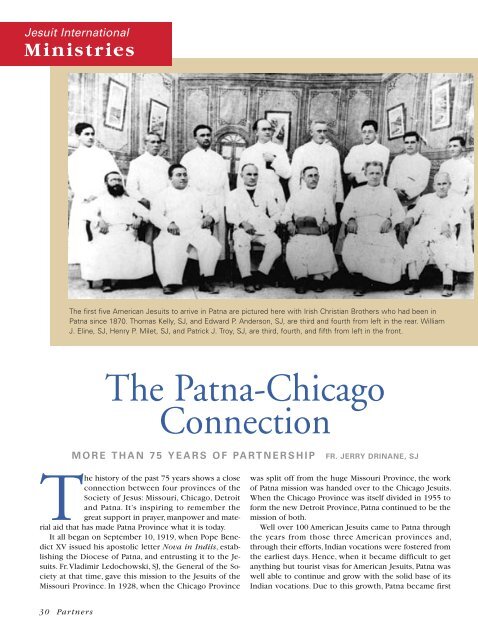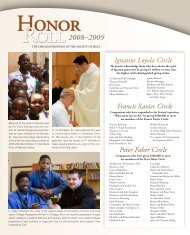1 - Chicago-Detroit Province
1 - Chicago-Detroit Province
1 - Chicago-Detroit Province
- No tags were found...
Create successful ePaper yourself
Turn your PDF publications into a flip-book with our unique Google optimized e-Paper software.
Jesuit InternationalMinistriesThe first five American Jesuits to arrive in Patna are pictured here with Irish Christian Brothers who had been inPatna since 1870. Thomas Kelly, SJ, and Edward P. Anderson, SJ, are third and fourth from left in the rear. WilliamJ. Eline, SJ, Henry P. Milet, SJ, and Patrick J. Troy, SJ, are third, fourth, and fifth from left in the front.The Patna-<strong>Chicago</strong>ConnectionM O R E T H A N 7 5 Y E A R S O F PA R T N E R S H I P FR. JERRY DRINANE, SJThe history of the past 75 years shows a closeconnection between four provinces of theSociety of Jesus: Missouri, <strong>Chicago</strong>, <strong>Detroit</strong>and Patna. It’s inspiring to remember thegreat support in prayer, manpower and materialaid that has made Patna <strong>Province</strong> what it is today.It all began on September 10, 1919, when Pope BenedictXV issued his apostolic letter Nova in Indiis, establishingthe Diocese of Patna, and entrusting it to the Jesuits.Fr. Vladimir Ledochowski, SJ, the General of the Societyat that time, gave this mission to the Jesuits of theMissouri <strong>Province</strong>. In 1928, when the <strong>Chicago</strong> <strong>Province</strong>was split off from the huge Missouri <strong>Province</strong>, the workof Patna mission was handed over to the <strong>Chicago</strong> Jesuits.When the <strong>Chicago</strong> <strong>Province</strong> was itself divided in 1955 toform the new <strong>Detroit</strong> <strong>Province</strong>, Patna continued to be themission of both.Well over 100 American Jesuits came to Patna throughthe years from those three American provinces and,through their efforts, Indian vocations were fostered fromthe earliest days. Hence, when it became difficult to getanything but tourist visas for American Jesuits, Patna waswell able to continue and grow with the solid base of itsIndian vocations. Due to this growth, Patna became first30 Partners
Students gather before classes at the Barauni Mission School. Many of the firstAmerican Jesuits assigned to Patna worked in mission schools like these.Tom Tobin, SJ, is visible in the rear of the above photo.a vice-province, and then, in 1962, an independent province.In the course of time, Patna too was divided, withtwo dependent regions: Nepal and Delhi.Early DaysOn March 6, 1921, the kindly and fatherly Belgian, Fr. LouisVan Hoeck, SJ, after 29 years of missionary life in Ranchi,south of Patna, was ordained Bishop of Patna. Ten dayslater, he welcomed to Patna the five “founding fathers,”the first American Jesuits in the Patna mission: Frs. WilliamJ. Eline, SJ, (Superior), Edward P. Anderson, SJ, Thomas Kelly,SJ, Henry P. Milet, SJ, and Patrick J. Troy, SJ.The Patna mission was not just beginning in 1921:each of the new missionaries found himself assigned toa neat little church and a small flock of ‘born’ Catholics:Indians, Anglo-Indians, and Europeans. In fact the missionalready had many churches, established by the CapuchinFathers: seven south of the Ganges River, and fourteen inNorth Bihar. Around these 21 churches, and in many villages,there were 5,021 Catholics. There were 9 CatholicFr. Marshall Moran, SJ, foundedSt. Xavier’s School in Patna in1940 before moving north tothe Kingdom of Nepal wherehe founded another St. Xavier’sSchool, which remains today apremier education institution inNepal.schools with 512 students.Between 1921 and 1937,Missour i and <strong>Chicago</strong><strong>Province</strong>s sent 59 Jesuitsto Patna. Of the first five“founders” only Fr. Elinedied in India, in 1943. Theothers, over the years, returnedto America because of poor health. As for the lovableBishop Van Hoeck, he visited the American Midwestin 1924 and remained Bishop of Patna until 1928, whenhe was called to become the first Bishop of Ranchi. Hegained a great deal of support from the Midwest Jesuits,and with this he was able to expand the school systemin Patna. When he departed for Ranchi, there were 28schools with 1,833 students: nearly a four-fold increase inseven years. In addition, he was the founder of the SacredHeart Sisters, the diocesan congregation that has done somuch to strengthen the Catholic communities througheducation and health care.Partners 31
were in need. So, in 1938, the Third Order Franciscansfrom Pennsylvania took up the work in Bhagalpur Districtand the Jesuits turned their attention to the other vastareas of the mission.Second PhaseThe second phase of growth took place among the depressedclasses of Indian society whom Mahatma Gandhicalled Harijans, or “the people of God.” Today they areknown as Dalits, or “oppressed” in the caste system. Forthem, the Christian message was a call for liberation inevery sense of the word. Fr. Westropp had already begunthis work in Chuhari and surroundings. Later, after histransfer from the Santal mission, he continued it south ofthe Ganges. The people there, weary from centuries of oppression,were turning towards Christianity or Buddhismin hopes of gaining a sense of equality and human dignity.At first the Jesuits’ work was among those of the Chamarcaste; now it is casteless, the beloved portion of the oneuniversal ‘people of God’.Dan Rice, SJ, one of the Jesuits who worked tirelessly onbehalf of the Santal people in India. Fr. Rice, who died in1991, is remembered by all as a truly loving and simpleperson.EducationThe first group of Jesuits quickly realized that a Catholichigh school was an imperative need, both to foster localvocations and to provide higher education for the Catholiclaity. Thus began Khrist Raja High School, an extensionof the middle school in the famed Bettiah parish. The yearwas 1927, and in 1929 the school was moved to its newand spacious premises outside the town. Meanwhile Patna,GrowthThe first phase of the Jesuits’work in Patna can be summarizedin the name of a pleasant people,the Santals. Fr. James Creane, SJ,another early Patna missionary,came upon them while exploringhis mission in Bhagalpur District.Bishop Van Hoeck encouragedhim, and he started a school forSantal children in Simra, southof Bhagalpur city. MeanwhileFr. Henry Westropp, SJ, anothergreat pioneer, discovered Santalsin Munger District and started aschool and dispensary at Chakai.The success of this work can bemeasured by the fact between1921 and 1938 the number ofCatholics in Patna Diocese grewfrom 5,021 to 21,240. It wasn’teasy to hand over such a successfulapostolate to others, butPatna’s Hindi-speaking areasEarly Jesuit communities in the Patna Mission were filled with American faces, likethis one at St. Xavier’s Patna. Pictured above are then Provincial Louis de Genova,SJ (3rd from right front row), then principal of St. Xavier’s, Gordon Murphy, SJ (4thfrom right), Richard Rosenfelder, SJ (2nd from right), Charles Scott, SJ (2nd from rightmiddle row) and Bob Schmidt, SJ (4th from right back row).32 Partners
the state capital, was growing, and the Church along withit. The Bishop resided there, and many thought the influenceof the Jesuits could be greatly extended through ahigh school. Fr. Marshall Moran, SJ, undertook this taskwith the encouragement of Fr. Frank Loesch, SJ, Superiorof the mission at that time, and founded St. Xavier’s in1940.A further far-reaching step was taken in 1943. When SirMirza Ismail, the Diwan of Jaipur in the State of Rajasthan,visited St. Xavier’s in Patna, he was so impressed that heprevailed on Fr Loesch to open the same type of school inJaipur. Today that school has a reputation that goes far beyondthe boundaries of Rajasthan. Finally, the Archbishopof Delhi persuaded the Jesuit General in Rome to askthe Patna Jesuits to open a school in the nation’s capital,Delhi. Since 1960 this school, one of the youngest of themall, has grown to be the biggest with over 3000 students.The next big educational venture was for a smallgroup of Jesuits to go to Nepal, where in 1951 Fr. Moranagain pioneered a St. Xavier’s school. Today it is a premierinstitution in the mountain kingdom.Just 40 miles west of Patna, another proof of thegrowth of the Church was the development of Ara into afull-fledged high school to cater to Catholic boys southof the Ganges River. This school has just celebrated itsgolden jubilee, and hundreds of young men (and nowyoung women as well, since it has become co-educational)are prospering because of their Ara education.DiversitySince 1970, a lot more diversity has come into the workof the Patna Jesuits. Social action centers were started inBettiah, Khagaul, Sasaram, Aurangabad and many of theparishes which are entrusted to the care of the Jesuits.This has meant more emphasis on village schools and primaryeducation, non-formal education, and adult literacyprograms. Another area of social justice concern is ourlegal aid apostolate in Patna and Bettiah. Several Patna Jesuitshave law degrees, and two are practicing in the PatnaHigh Court. Through the initial efforts of Fr. Jack Barrett,SJ, and Fr. Raphael Sah, SJ, an active apostolate of the presshas developed. But while the work has expanded in variousdirections, the importance of education has not beenforgotten.Three new high schools in Latonah, Barbigha, and Aurangabad,have been started. In Nepal and Delhi also, inaddition to the formal schools, there are many other areasin which Jesuits contribute to the development of thelocal people: centers for social action, youth care, rehabilitationof drug addicts, and more. Much of this workis supported and aided by former students of our schoolswho now have influence in government and society.Bonds with <strong>Chicago</strong>Generous people throughout the United States have contributedsubstantially to the growth of Patna mission, butthe vast majority of their efforts have been channeledthrough the <strong>Chicago</strong> <strong>Province</strong> Mission Offices in <strong>Chicago</strong>and Cincinnati. Many of the Indian Jesuits ofPatna have been financed in their higher studiesin the States through the help of benefactors ofthe <strong>Chicago</strong> <strong>Province</strong>. Patna Archbishop, BenedictOsta, SJ, former provincials Abraham Puthumana,SJ, and John D’Mello, SJ, did their theologicalstudies at West Baden College in the <strong>Chicago</strong><strong>Province</strong>. To this day, some Patna Jesuits everyyear are helped in getting degrees in the UnitedStates through donor support. This bonding alsocontinues through the "convenio" union, whichcalls for deepening collaboration between thePatna and <strong>Chicago</strong> <strong>Province</strong>s.Today the communities are filled with Indian Jesuits, as evidencedby the recent picture of novices from the Patna <strong>Province</strong>. In fact,thanks to the tremendous growth in native vocations, the Patna<strong>Province</strong> today has roughly 400 members as compared to 250 inthe <strong>Chicago</strong> <strong>Province</strong>.Our Debt of GratitudeHence it is with a deep sense of gratitude thatwe in Patna congratulate the <strong>Chicago</strong> <strong>Province</strong>on its “platinum” jubilee. Looking back, it is trulya miracle of Divine Providence that has accomplishedso much in a land so far away. We sincerelythank the Jesuits of <strong>Chicago</strong> <strong>Province</strong>, ourbenefactors and friends, for making Patna <strong>Province</strong>what it is today. And we pray that God maybless our mother province with many vocationsand an abundance of spiritual gifts. ■Partners 33





